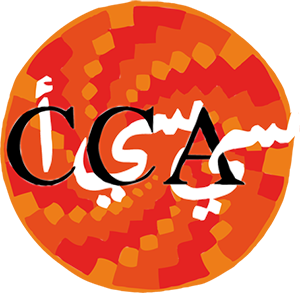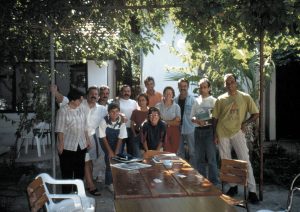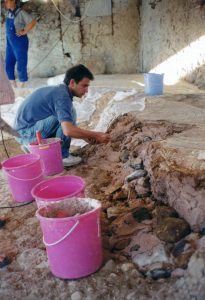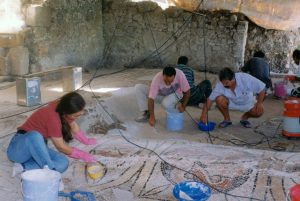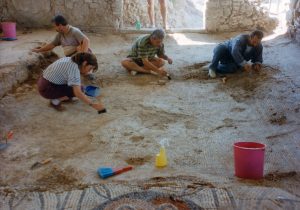In the context of initiatives promoted by the International Center for the Study of the Conservation and Restoration of Cultural Property (ICCROM) to increase awareness of the importance of conserving the original message of archaeological mosaics, CCA was asked in 1995 to organize and implement a training course on conservation of in situ mosaics in archaeological sites.
The course was addressed to twelve restorers and archaeologists from various public institutions and museums in Turkey.
For centuries, mosaics were detached from their sites following a misguided idea that they were being thereby protected. If displayed, they were usually far from the place to which they belonged. Often treated as minor art objects, they were abandoned to a fate of neglect and oblivion in museum storage. After twenty years of efforts on the side of various institutions and individual professionals in the field to promote in situ conservation without detachment, only in the 1990s archaeologists began to realize that detaching mosaics involves serious risks, not only for their material conservation but also for the loss of significance and the destruction of their original archaeological context.
Conserving mosaics in situ together with wall paintings and other decorated surfaces of the original architecture is primarily an ethical issue and only later a technical one. After years of experimenting with materials and treatment techniques, an approach has finally emerged that reduces the impact on original materials to the minimum. This methodology uses consolidation treatments with lime-based materials, at the same time stressing preventive conservation and maintenance.
The three-week course was developed in collaboration with the Central Conservation Laboratory of Turkey in Istanbul.
In the first week, thanks to various contributions by archaeologists and conservators, participants tackled the themes and learnt about the importance of conservation in situ.
The second and third weeks were dedicated to technical field training, conserving a 5th century polychrome mosaic in the archaeological site of Side as exercise.
Working alongside the CCA conservators, participants directly experienced treatment techniques based on the use of lime-based materials. During the intervention, they put into practice all the procedures that are usually applied during conservation in situ: planning, preventive conservation measures, preparation of the worksite, documentation, tesserae consolidation and deep consolidation, cleaning, stuccoing, final presentation and reporting.
Course objectives were to transmit a preventive approach to the participants and to let them developing a broader view of problems, starting with the premise that conservation in situ is a cultural choice linked to integral respect for archaeological sites. The technical treatment, albeit important and necessary, is only one aspect of a wider preservation action.
Course participants were Fazim Agikgoz from Nidge; Mehmet Akif Isin from Telurdag; Figen Caren from Lefkosa, Cyprus; Unal Demirer from Antalya; Fuat Dereli from Sinop; Gulseren Dikilatas from Istanbul; Hande Gunyol from Istanbul; Celal Kuciuk from Istanbul; Kazim Mertek from Konia.
Course director was Ulku Izmirligil.
Course coordinators were Revza Ozil and Roberto Nardi.
Teachers were Roberto Nardi and Gaël de Guichen.
Course assistant was Romana Albini
